"Why is the Sky Blue?" and "Where does Protein come from?" explained in one graphic

This image is a condensed layman's version of my university education in Biology, to supplement my article a few months ago. It seeks to explain human nutrition using biochemical, evolutionary, and ecological backdrops. Since I consider it a summary of my own understanding, and not a definitive source of information, I won't be linking to sources (though I'm more than willing to provide clarification in the comments). I've purposely avoided religious or philosophical discussion here.
In the relative beginning
About 4,600,000,000 years ago, a star and several planets formed out of matter left from a previous generation of solar systems in this region of space. For millions of years, the planets were battered by impacts from space, and volcanic eruptions vaporized the waters. On the 3rd planet, temperatures were eventually right for bodies of liquid water to pool on the mineral crust, around the molten core.
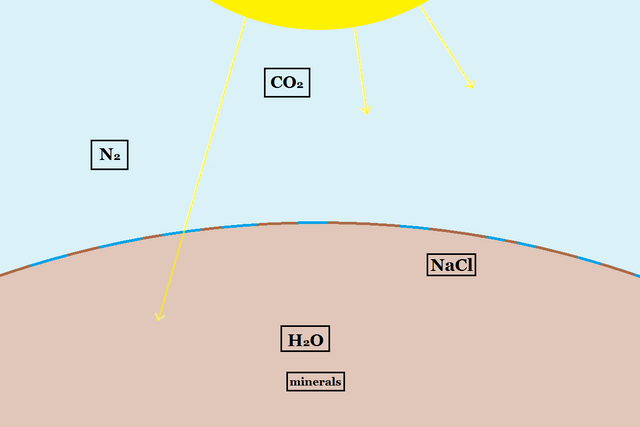
Intense rays beat down on the surface of the planet from the nearby young star. The atmosphere was made almost entirely of nitrogen gas (which is why our sky is blue). Volcanoes belched out CO2, the only other gas of note in young Earth's air. Salt and other minerals (like calcium, magnesium, iron, potassium, phosphorous, sulfur, etc) collected in oceans as fresh rainwater soaked the barren landscapes.
Life
When you put those minerals together with nitrogen gas, carbon dioxide, water, heat, and solar radiation, sometimes you get amino acids. Scientists have replicated this in the lab for decades. The molecules that make up living things can be created by natural forces alone. Given enough time, it seems that life will find a way.
Amino acids are the building blocks of all life. All our proteins, and even our DNA, is made of chains of these simple nitrogen-containing units. Your proteins are what make you you, and not an oak tree - everything else is basically the same.
We call the process of creating amino acids from nitrogen gas "nitrogen fixation", and it also fixes carbon dioxide. The end products are amino acids and some waste chemicals, such as ammonia (NH3).
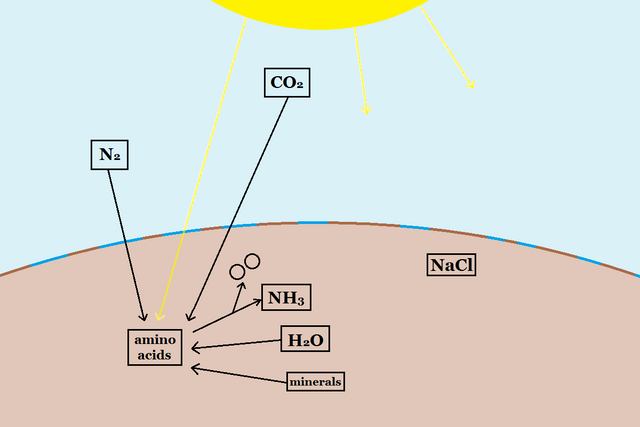
(You've already learned most of first year Biology, and part of 2nd year Biochemistry. Keep going!)
Nitrogen fixing generated chains of amino acids - simple proteins - which made copies of themselves. We don't know how long it took or exactly how it happened, but these self-copying proteins got inside a thin oily membrane, and bacteria took over the Earth.
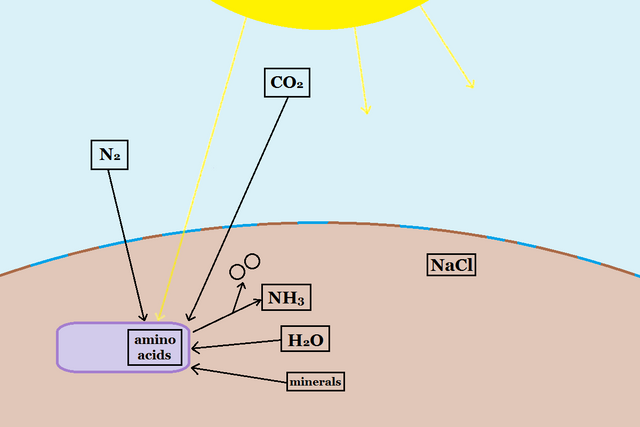
And they're still at it today - they have adapted to literally every environment found on the planet, but all bacteria are essentially unchanged from that original reaction. Bacteria are how nitrogen gets from our atmosphere into a form living things can use (amino acids, ammonia, etc). It's a good thing they're still doing it today, because without them, all life on Earth would end!
Nature found a way to take advantage of the huge amount of bacterial waste products piling up. The water was already abundant in minerals, but when ammonia came along, plants soon emerged - and changed the planet forever.
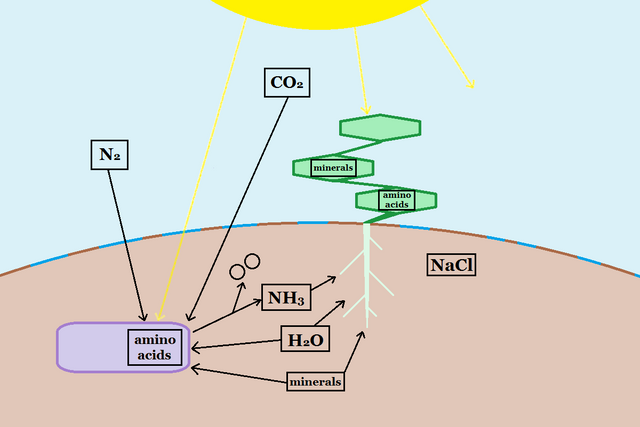
Plants absorb water containing ammonia and minerals, which are built into amino acids at the mitochondria. Just like in bacteria, amino acids are linked into chains at the ribosomes, creating any protein the plant needs.
Bacteria aren't just the plants' ancestors, they're also the their life support! Without the continuous supply of bacterial waste product - ammonia - biosynthesis would cease and all plants would die.
(That's more than half of it! Stay focused for the fun part.)
Plants have another key function: harvesting the power of sunlight with their chloroplasts (which are what make plants green). Photosynthesis fixes carbon dioxide from the air to water absorbed by the roots, creating sugar. Sugar is sunlight stored in chemical form.
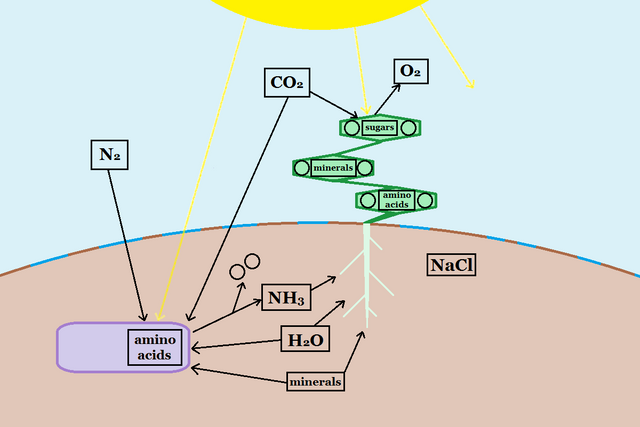
One of the waste products of photosynthesis is oxygen gas, which was poisonous to most bacteria at the time, causing a partial die-off. Today there are still some bacteria that tolerate oxygen (aerobic) and some that don't (anaerobic). As the level of oxygen rose, new forms of life emerged to take advantage of it.
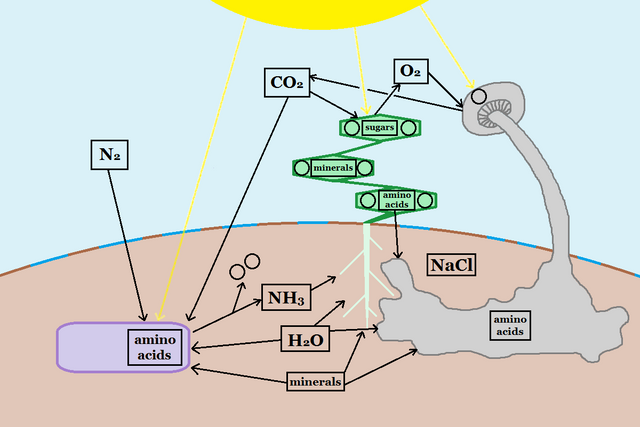
Fungi live in close harmony with plants. They breathe oxygen and give off carbon dioxide, fitting perfectly into the gas exchange cycle. Fungi get their amino acids from decaying dead plants, absorbed with water and minerals by their hyphae. A mutually-beneficial mycorrhizal association develops between fungi and the roots of most plants.
With the help of bacteria and fungi, plants colonized the lands, and adapted to a variety of conditions. Oxygen continued to be an abundant resource in the atmosphere.
Animals
This group of lifeforms appeared and grew in number and complexity. They could absorb oxygen from their environment, using it to power many biological systems, and giving off carbon dioxide into the gas exchange cycle.
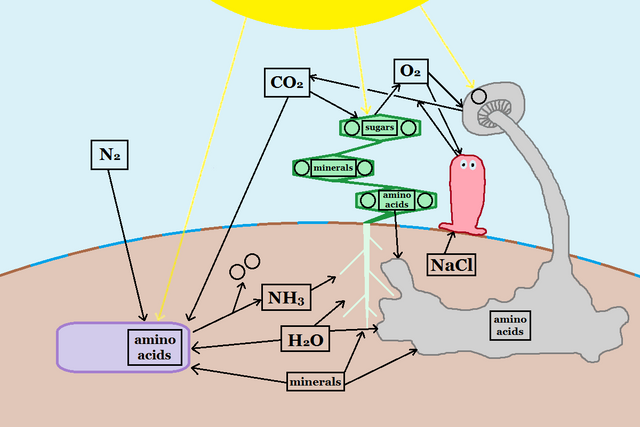
Animals can't fix nitrogen from the air, can't absorb ammonia with roots, and can't uptake amino acids from decaying matter. Instead, animals get their amino acids in a new way: eating and digesting them. But then, like every other life form, animal cells turn amino acids into specific proteins at the ribosomes.
The animals developed something the other lifeforms don't have, which is a nervous system. This upgrade required sodium and chloride ions, which most obtained from their environment in the form of sea salt. Nerves interpret senses, react, make decisions, have feelings, learn biology, and more.
To power these upgrades, animals needed another source of energy, which they obtain as sugars, primarily from plant sources. Plants are also where most animals get their minerals.
Animals also require a few specific chemical compounds from their environment, considered essential because the organism can't produce it on their own. In humans, these "vitamins" are called A, B, C, D, E, F, J, and K. Vitamin D is produced (as protection) by exposure to sunlight, in both humans and fungi. You're getting a dose when you eat mushrooms or go out in the sun. The other vitamins are found in various plants, and we're helped by bacteria (such as within our gut) to get all the forms of B and K.

Most animals (including humans) are able to obtain everything they need from the environment, with help from plants, bacteria, and fungi. Some animals have developed to eat other animals (either by killing them first, or by scavenging the dead). Humans are able to digest other animals, but don't require them for nutrition.
Where humans get their essential nutrients

The water and salt have been there all along, but everything else requires a complex and balanced ecosystem to support. Animals would disappear immediately if any part of the system failed. Our existence depends on us fully understanding and respecting this balance.
Nitrogen is life
Once you understand the above, you've got the majority of a biology degree under your hat. Now, I think it's useful to follow the path nitrogen makes as it goes from an inert gas making up most of our atmosphere, to the proteins in your body that make you who you are.
- nitrogen gas is fixed with carbon dioxide and water, using solar radiation to catalyze the reaction, producing basic amino acids and ammonia
- you eat and digest those bacterial amino acids
- the ammonia is absorbed by plant roots, transported to the mitochondria, and processed into amino acids
- you eat and digest those plant amino acids
- when plants decompose, their amino acids are taken up by fungi, which you eat and digest
- amino acids from your diet are joined together into proteins at your cells' ribosomes
- every part of your body is built out of protein, and it got there through bacteria and plants
The next time somebody asks you why the sky is blue, you can explain how the blue nitrogen from Earth's sky goes into building every living cell on the planet.

DRutter

Thank you for this informative, well-written biology lesson, @Drutter
Epic illustrations!